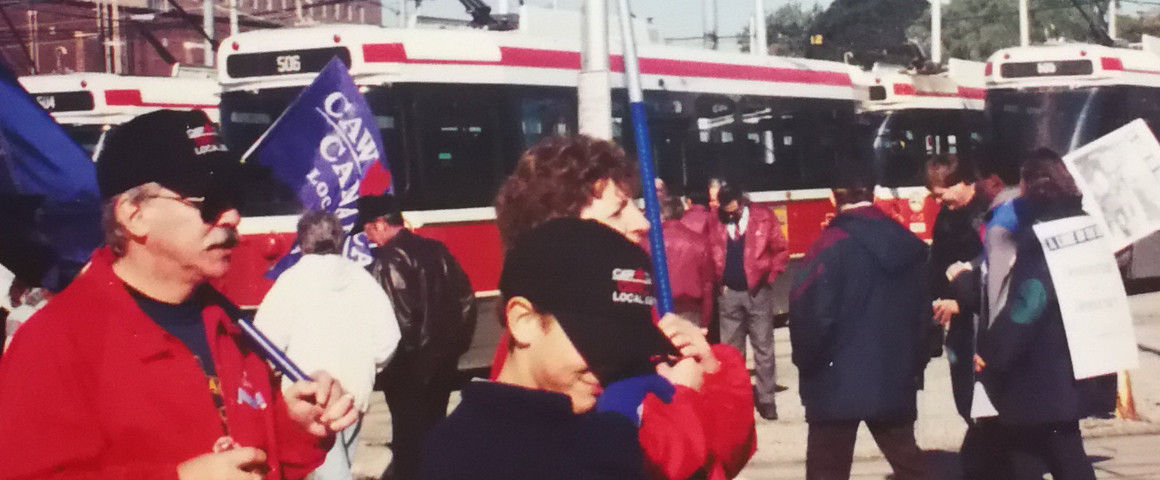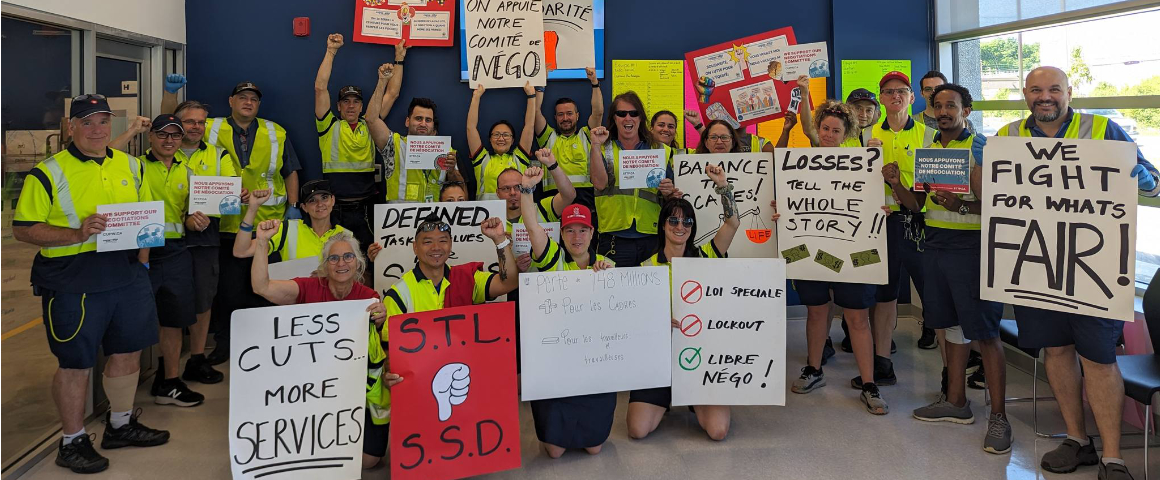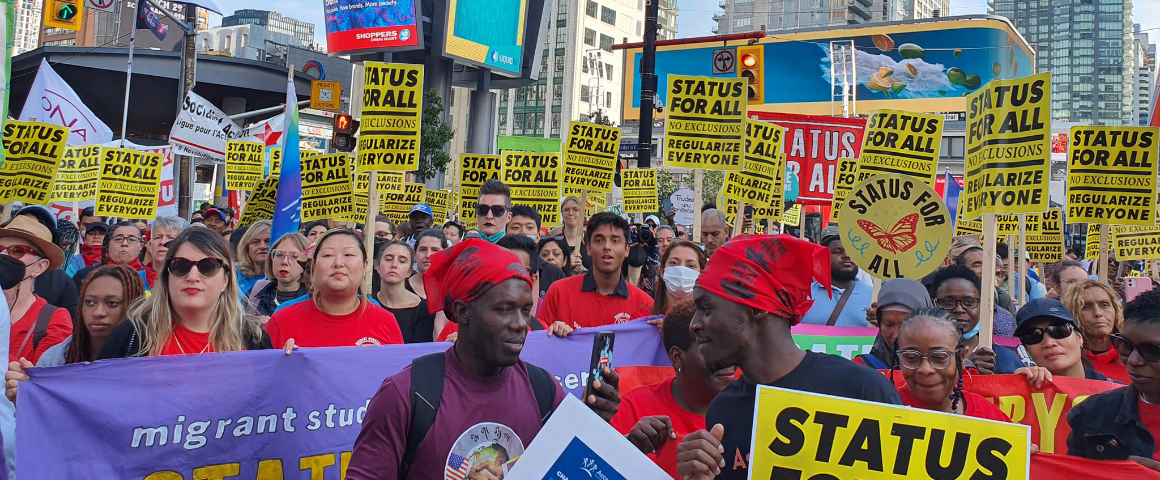By Dave McKee
Friday, October 25, 1996. I got up very early – around 4 in the morning – and called a cab because Toronto’s transit system was down. As I made my way through the city’s east end, it was hard to not get excited by the streets whose eerie silence was notable, even at the early hour. There were no buses, no delivery vans, no garbage trucks, no traffic. The radio in the cab confirmed what we already knew to be the case: the working class had stood up and shut down the largest city in the country.
It was the Metro Days of Action, and I was on my way to a picket line. It was, and still is the most thrilling moment in my political life.
On this 25th anniversary of that historic shutdown and subsequent demonstration by 250,000 people, it is easy to remember the Metro Days of Action (MDA) as a single event. That would be a mistake. In the first place, the general strike on October 25 and mass rally on October 26 were the culmination of a full week of actions throughout the six municipalities which made up Metropolitan Toronto. These actions ranged from street theatre to vigils, from banner drops to protests and marches.
But more significantly, the MDA emerged from a full year of escalating province-wide resistance to the Conservative government of Mike Harris. This was a campaign that built active unity between labour and community organizations at the local level and coordinated those coalitions into a provincial network. What this meant concretely in Toronto was that the Toronto and York Region Labour Council, working with its main community partner the Metro Network for Social Justice (MNSJ), mobilized support and participation in scores of resistance actions in Toronto and throughout Ontario.
So, when the first of the rotating Days of Action was organized in London, Ontario in December 1995, several dozen busloads of protesters arrived from Toronto (in addition to many from other communities) to bolster the shutdown and rally by 10,000 local workers and residents. This effort was followed up by a huge 100,000-strong Day of Action in Hamilton in February 1996 and large ones in Cambridge/Kitchener/Waterloo and Peterborough in the spring and early summer.
Through this engagement, the working class was gaining experience necessary for escalating the struggle. As Linda Torney, then president of Metro Toronto’s labour council wrote:
“In the meantime, the Toronto and York Region Labour Council was continuing to develop a solid base for resistance. They called a special meeting of Toronto area delegates at the Ontario Federation of Labour convention, which gave birth to the Council’s Solidarity Committee. It met regularly to plan ‘fight back’ events, generate new ideas for building the movement, and organize support for the Days of Protest activities in London and Hamilton. The Solidarity Committee also organized support for strikes and lockouts within the Council’s geographic area… By March of 1996, the Labour Council had been effectively building resistance for over 6 months.”
Across Metro Toronto, community-labour solidarity organizations were formed to bring together public and private sector trade unionists and social justice and community activists. While they were not creatures of labour council, these groups were closely connected to it and to the MNSJ. Community-labour coalitions like the East York Action Committee and North York Fights Back were critical to organizing resistance over several months and mobilizing support for the MDA, particularly for the Metro-wide general strike.
There are criticisms that the composition of local and provincial coalitions was heavily curated by the labour leadership, with the result that some key grassroots movements were marginalized. While these concerns are valid in certain cases and need to be part of any assessment of building mass resistance, this doesn’t diminish one of the main lessons from the MDA – the need for organization. Bluntly put, without that year of preparation and coordination from the local to the provincial level, the calls to shut down Toronto would have been little more than the self-indulgent and empty leftist sloganeering that is heard all too often today.
Besides the critical need for preparation, there are several other lessons that can be drawn from the Metro Days of Action (and from the province-wide struggle generally). But the most important are those that provide insight into how to build and advance the class struggle in the current conditions. Here are some:
Community-labour solidarity is key
We often speak of the importance of the trade union movement to building mass resistance, and with good reason. The labour movement is massive and has the ability to fund, organize and sustain a wide-scale struggle over the long term. More importantly, though, is the fact that it is unique among social movements in that it is organized at the point production. No other movement has the same capacity to bring protest to the economic level.
On the other hand, the fact that labour is not a politically self-selecting movement can hinder its ability to mobilize. Unlike social justice groups, which people join because of a shared political commitment, trade unions are composed of people who share a workplace or trade and whose focus is their job and working conditions. This often means that labour is slower to move into political action, as unions need to educate and organize their members for what many see as a secondary consideration.
During the resistance to Mike Harris, then, it is unsurprising that the social and community movements were first to organize. The earliest actions against the government were launched by the Ontario Coalition Against Poverty and other anti-poverty groups across the province, and by the Ontario base of the National Action Committee on the Status of Women. This was critical to paving the way for labour to become involved in the struggle, by supporting these and other community movements, and to rev up its own engine in order to lead it.
The most recent effort to build a structured community-labour solidarity movement in Ontario was the Ontario Common Front, initiated in 2012 by then OFL president Sid Ryan. The campaign, which brought together 100 union and community bodies, was effectively scuttled by union leaders who opposed mass struggle in favour of mobilizing votes for the NDP. In the wake of its shut down, the OFL has been unable to provide anything close to the leadership required for an escalating movement of the working class.
Unity matters
Without question, one of the reasons for labour’s current relative weakness is a lack of organizational unity. The involvement of the Canadian Auto Workers (CAW) was key to the Days of Action, but the CAW’s successor Unifor left the Canadian Labour Congress in 2018 and was consequently tossed from provincial federations and local labour councils. The absence of the largest private sector union in the country, with about 150,000 members in Ontario and a concentration in major manufacturing industries, is definitely a problem.
But there were also deep divisions within the labour movement in the late 1990s. Public sector workers in Ontario reeled under the attack on their collective bargaining rights by the NDP government of Bob Rae, in the form of the 1993 Social Contract which mandated wage freezes and unpaid days of leave. As a result, public sector unions withdrew their support for the NDP and were joined in this by the CAW, meaning that the party lost the majority of its labour support. In response, twelve major private sector unions (called the “pink paper unions” at the time) denounced the public sector unions and CAW, declared their continuing support for the NDP and threatened to split the Ontario Federation of Labour (OFL) over the issue.
In the early days of the Harris government, this division within the OFL was apparent, with pink paper unions often pointedly blaming the public sector and CAW for the Conservative election victory. But by the time of the London Day of Action, most had put away their “Don’t blame me, I voted NDP!” buttons and were working alongside the other unions in local community-labour solidarity committees.
The differences did not disappear – in fact, they ultimately played a destructive role in the province-wide struggle – but the concrete work of building the fight against the government, whose policies were understood as threatening by the vast majority of union members, necessitated and facilitated a working unity of the entire labour movement.
Similarly, while the current divisions within labour appear nowhere close to being resolved, a genuine campaign of action to resist austerity and neoliberalism, and to demand a People’s Recovery, offers a realistic and progressive conduit for rebuilding unity. The current conditions require nothing less.
A protest movement can only go so far
Coming on the heels of successful shutdowns in four other cities, the Metro Days of Action showed, beyond any doubt, that the working class in Ontario had the organizational capacity to launch a province-wide strike. This was the trajectory that had always been on many people’s minds, and it was a common theme during the MDA. (“Metro today, province-wide tomorrow!”)
But while the organizational strength was apparent, the political direction of the Days of Protest campaign was far less so. It was more common to see a placard bemoaning that the Harris agenda was “Too much, too fast!” than one calling for the Conservatives to resign. Furthermore, this range of perceived solutions was reflected right in the committees organizing the actions. On the steering committee of the East York Action Committee, for example, some people said they simply needed the government to “slow down” while others called for Harris to be brought down before the next provincial election.
Faced with such potentially destructive differences, the answer (or so it seemed at the time) was to focus on that which united us: the need to protest what the government was doing right now. Unfortunately, whether through insufficient dedicated attention or lack of time, the political divide never got bridged. Despite all the incredible achievements, even at the time the MDA never really felt like more than a protest movement. There was never even a minimum political program articulated, upon which to sustain the movement over the long term.
This weakness was one of the decisive factors in the demise of the Days of Protest. About two years into the Conservatives’ term, focus began to shift away from escalating the protests to supporting the NDP in the next election. There were several factors at play in this, but one of the big ones is the view that if the movement doesn’t have a political plan heading into an election, it needs to step aside for someone who does. That someone, people were told, was the NDP. The point here is not whether that party’s plan was the right one for the working class. Rather, the issue is that this massive movement of the working class had not articulated even the basic elements of a plan, to which it could ask the NDP or any party to measure up. Quite simply, by focusing almost exclusively on being a protest movement, it left itself feeling that it had no tactical options heading toward the election.
While labour’s organizational independence launched and carried out the Days of Action, labour’s political dependence squelched them.
In such a situation, opportunism tends to have the upper hand. After the NDP tried and failed to turn the Days of Action into a re-election tour, the OFL leadership wound the campaign down and abruptly ended it. In the election, the Conservatives held onto a slim majority while the NDP lost half its seats.
Currently, as it faces another right-wing Conservative government the OFL is far less politically engaged than it was during the Harris years. Its most consistent and visible “action” is a clock on its website that counts down the days until the next provincial election. Ironically, the OFL itself provides workers in Ontario with the grim reminder of how long they must suffer under Doug Ford without a fighting labour federation to help them. As the OFL stubbornly avoids developing and projecting an independent political program for labour, Ontario risks seeing a Ford re-election. History, as they say, repeats itself – first as tragedy, then as farce.
The class struggle cannot be put out
Facing the executioner following the Haymarket Riot in Chicago in 1886, labour leader August Spies insisted that the class struggle would continue. “If you think that by hanging us, you can stamp out the labor movement – the movement from which the downtrodden millions, the millions who toil and live in want and misery … if this is your opinion, then hang us! Here we will tread upon a spark, but there, and there, and behind you and in front of you, and everywhere, flames will blaze up. It is a subterranean fire. You cannot put it out.”
One of the most remarkable lessons from the Metro Days of Action was how the class struggle does, indeed blaze up. When the Harris government was elected in June 1995, it was on a wave of working-class support which included an estimated 30 percent of trade union members. Within just six months, many of those workers were not only attending protests against Harris but were actively downing their tools and becoming involved in political organizing. While the Days of Action ended sourly, the experience gained by tens of thousands of working people cannot be diminished.
Labour writer Lorraine Endicott captured this in Our Times magazine, a month after the Metro Days of Action:
“I think it’s true what people are saying: Toronto will never be the same again. The streets may look the same. It will still snow in the winter. But the days of action have changed the chemistry of many of our lives. We are stronger than we were before. We no longer feel the rule of greed is an inevitable fate. We feel engaged again. We feel there is hope. And hey! If we can stop a city like Toronto, what can’t we stop? No one can take these days away from us. They are ours.”
At the end of the mass rally on October 26, labour council president Linda Torney spoke to the crowd and asked them to commit to the slogan of the Metro Days of Action: “Organize, educate, resist.” A quarter of a million of us took that pledge. While 25 years have passed, there’s still time – and an urgent need – to carry it out.
[hr gap=”10″]
Get People’s Voice delivered to your door or inbox!
If you found this article useful, please consider subscribing to People’s Voice.
We are 100% reader-supported, with no corporate or government funding.




